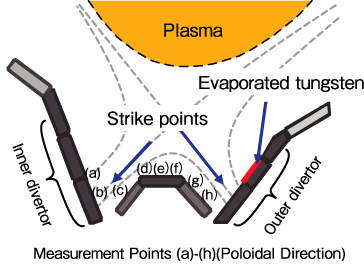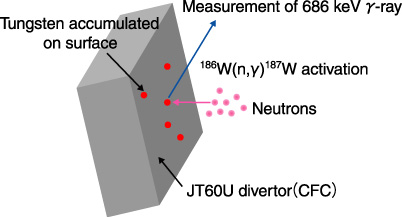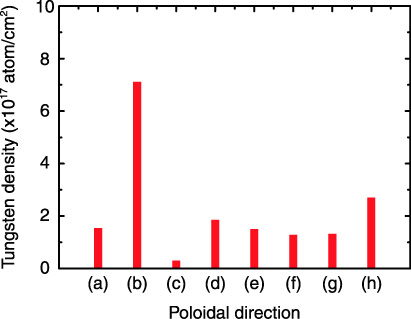
Fig.3-23 Poloidal cross-sectional view of the divertor in JT-60U and measurement positions

Fig.3-24 Principle of the activation analysis method using the 186W(n,γ)187W reaction

Fig.3-25 Surface density distribution of deposited tungsten along the poloidal direction
Tungsten is one of the most promising candidate materials for the plasma facing wall and divertor in nuclear fusion reactors, but when tungsten becomes sputtered and transported into the plasma as an impurity, it significantly cools the plasma due to the radiation effect, and the plasma performance degrades. In order to prevent tungsten being transported into the plasma, it is essential to clarify the transport mechanism of tungsten that is evaporated and/or sputtered from the plasma facing components. This requires accurate measurement of tungsten deposited on the plasma facing wall and divertor. Thus far ion and electron beams have been typically used as the measuring method, but the quantitative measurement of such traces of tungsten has been technically so difficult that developing a new method has been a significant issue. In this study, we focused on γ-rays emitted from 187W produced in the 186W(n,γ)187W reaction and developed a new measurement method for trace amounts of tungsten with an activation analysis method. Fig.3-23 shows the poloidal cross sectional view of the divertor in JT-60U and measurement positions. The principle of the activation analysis method using the 186W(n,γ)187W reaction is illustrated in Fig.3-24.
A tungsten divertor, composed of carbon fiber composite (CFC) tiles on which tungsten 50 μm in thickness was evaporated, was set up in the outer divertor region, and plasma discharge experiments were conducted involving more than 1000 shots in JT-60U. After all the plasma discharge shots, the CFC tiles near the tungsten divertor were removed (Fig.3-23(a) ~ (h)) and were cut into pieces about 1 cm square and 2 mm thick as analysis samples. They were then irradiated with DT neutrons at the Fusion Neutronics Source (FNS) facility in JAEA. The sample pieces were surrounded by beryllium metal blocks to improve the measurement accuracy of the 186W(n,γ)187W activation analysis by providing enhanced thermal neutrons. After neutron irradiation, we measured the 686 keV γ-rays emitted from the 187W isotope produced in each sample, and thus the tungsten atom density on the CFC divertor surface was finally deduced. Fig.3-25 shows the distribution of tungsten density along the poloidal direction. Using this activation method, we were able to provide the first experimental observation that tungsten sputtered by the plasma tended to accumulate at the strike point where exhaust particles concentrated.